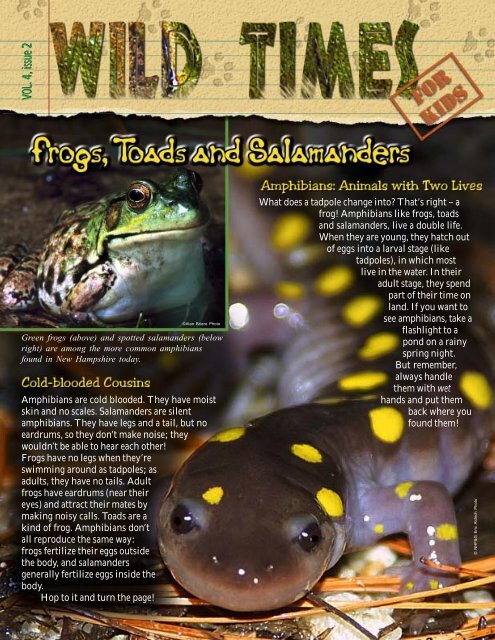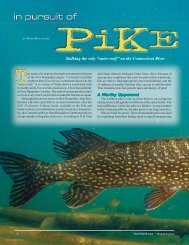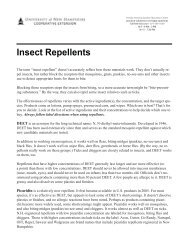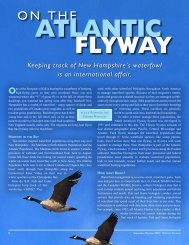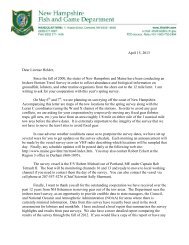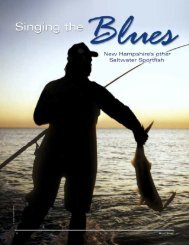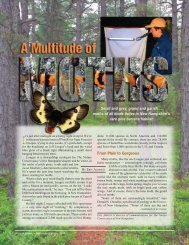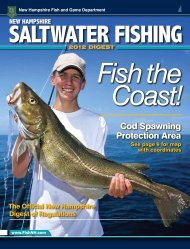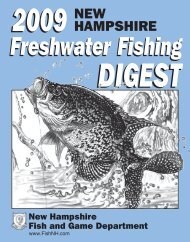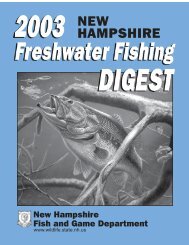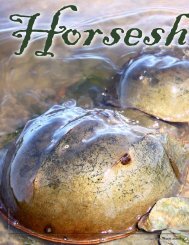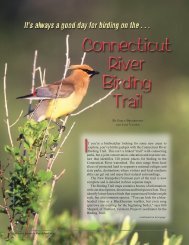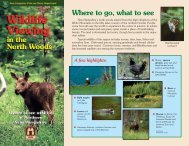to download Frogs, Toads and Salamanders (PDF file, 560 KB)
to download Frogs, Toads and Salamanders (PDF file, 560 KB)
to download Frogs, Toads and Salamanders (PDF file, 560 KB)
You also want an ePaper? Increase the reach of your titles
YUMPU automatically turns print PDFs into web optimized ePapers that Google loves.
VOL. 4, issue 2<br />
©Alan Briere Pho<strong>to</strong><br />
Green frogs (above) <strong>and</strong> spotted salam<strong>and</strong>ers (below<br />
right) are among the more common amphibians<br />
found in New Hampshire <strong>to</strong>day.<br />
Amphibians are cold blooded. They have moist<br />
skin <strong>and</strong> no scales. Salam<strong>and</strong>ers are silent<br />
amphibians. They have legs <strong>and</strong> a tail, but no<br />
eardrums, so they don’t make noise; they<br />
wouldn’t be able <strong>to</strong> hear each other!<br />
<strong>Frogs</strong> have no legs when they’re<br />
swimming around as tadpoles; as<br />
adults, they have no tails. Adult<br />
frogs have eardrums (near their<br />
eyes) <strong>and</strong> attract their mates by<br />
making noisy calls. <strong>Toads</strong> are a<br />
kind of frog. Amphibians don’t<br />
all reproduce the same way:<br />
frogs fertilize their eggs outside<br />
the body, <strong>and</strong> salam<strong>and</strong>ers<br />
generally fertilize eggs inside the<br />
body.<br />
Hop <strong>to</strong> it <strong>and</strong> turn the page!<br />
What does a tadpole change in<strong>to</strong> That’s right – a<br />
frog! Amphibians like frogs, <strong>to</strong>ads<br />
<strong>and</strong> salam<strong>and</strong>ers, live a double life.<br />
When they are young, they hatch out<br />
of eggs in<strong>to</strong> a larval stage (like<br />
tadpoles), in which most<br />
live in the water. In their<br />
adult stage, they spend<br />
part of their time on<br />
l<strong>and</strong>. If you want <strong>to</strong><br />
see amphibians, take a<br />
flashlight <strong>to</strong> a<br />
pond on a rainy<br />
spring night.<br />
But remember,<br />
always h<strong>and</strong>le<br />
them with wet<br />
h<strong>and</strong>s <strong>and</strong> put them<br />
back where you<br />
found them!<br />
© NHF&G Eric Aldrich Pho<strong>to</strong>
If you want <strong>to</strong> find frogs, follow your<br />
ears! The best way <strong>to</strong> locate frogs is by listening<br />
for them at night, when the wetl<strong>and</strong>s come<br />
alive with a chorus of peeping, whistling <strong>and</strong><br />
croaking. You’ve probably heard spring peepers<br />
making their high-pitched bell-like whistling<br />
song in the early spring, but did you know all<br />
that racket is made by little frogs as small as<br />
your thumb<br />
Other frogs,<br />
like the<br />
bullfrog, are<br />
much bigger.<br />
Listen for the<br />
© Steve Roble Pho<strong>to</strong><br />
Spring peepers<br />
calling (above)<br />
<strong>and</strong> mating (below).<br />
bullfrog’s<br />
deep, booming<br />
“jug-o-rum” call<br />
later in the summer.<br />
Sounds made by<br />
frogs <strong>and</strong> <strong>to</strong>ads are very<br />
important during mating <strong>and</strong> courtship. Only<br />
the males sing. Most frogs have at least two<br />
different calls; some have more. Advertisement<br />
calls tell female frogs, “I’m here, pick me!”<br />
They also let other males know that a terri<strong>to</strong>ry<br />
is taken. Another kind of song, called a courtship<br />
call, is given by males <strong>and</strong> some females<br />
shortly before they mate. During egg-laying,<br />
the males climb on the backs of the females. A<br />
release call may be given after mating has<br />
taken place. There are also defensive calls that<br />
adults <strong>and</strong> young of both sexes<br />
make when startled<br />
or attacked.<br />
Duck-like quack<br />
A short snore<br />
© Alan Briere Pho<strong>to</strong><br />
“Jug-o-rum”<br />
© Steve Roble Pho<strong>to</strong><br />
Sounds like a rapid series of<br />
hammer blows
©Alan Briere Pho<strong>to</strong><br />
High, bell-like whistle<br />
A long twill<br />
©NHF&G Vic<strong>to</strong>r Young Pho<strong>to</strong><br />
A short twill<br />
Sounds like a thumb pulled slowly<br />
across an inflated balloon<br />
Dull twang, like a banjo<br />
© NHF&G Vic<strong>to</strong>r Young Pho<strong>to</strong><br />
©NHF&G Vic<strong>to</strong>r Young Pho<strong>to</strong>
WHERE TO FIND SALAMANDERS<br />
Salam<strong>and</strong>ers are relatively easy <strong>to</strong> identify because of their smooth skin, long tail <strong>and</strong> four legs. Some adult<br />
salam<strong>and</strong>ers are found only in water, while others are only terrestrial (found on l<strong>and</strong>); still others spend some<br />
of their time in water <strong>and</strong> some on l<strong>and</strong>. They are usually small <strong>and</strong> remain hidden from view.<br />
Have you ever seen a salam<strong>and</strong>er<br />
©Dwight Kuhn Pho<strong>to</strong><br />
Believe it or not, the red-backed salam<strong>and</strong>er is our<br />
most common l<strong>and</strong> animal. Most of us have never seen<br />
a redback, because they are creatures of the forest floor,<br />
hiding under rocks <strong>and</strong> logs <strong>and</strong> in the forest litter. In<br />
mid-summer, the female deposits 3-14 eggs on the roof<br />
of a cavity in a rotting log or in the leaf litter. She<br />
remains with the eggs until they hatch in late summer<br />
or early fall. The larvae complete their transformation<br />
while in the eggs, so they emerge as adults.<br />
The mudpuppy is an aquatic-based salam<strong>and</strong>er,<br />
living its entire life in the water. This salam<strong>and</strong>er<br />
shouldn’t be here; it was introduced in<strong>to</strong> some of<br />
New Hampshire’s rivers by accident. This large<br />
salam<strong>and</strong>er may be over a foot long! It is always<br />
found in running water. A permanent larval<br />
form, it has bushy red gills throughout its life.<br />
©Dwight Kuhn Pho<strong>to</strong><br />
This is New Hampshire’s state amphibian.<br />
Many of us have seen the brightly colored, reddishorange<br />
l<strong>and</strong> form of the red-spotted newt. At this<br />
stage, it’s called an “eft.” The life his<strong>to</strong>ry of the newt<br />
is slightly different from other salam<strong>and</strong>ers. Newt<br />
eggs are laid singly <strong>and</strong> are attached <strong>to</strong> an underwater<br />
plant. The larvae hatch in about a month. After<br />
three months, young efts emerge from the water.<br />
This is when they are bright orange. Look<br />
for them in moist woods. After one <strong>to</strong> three<br />
years, the efts return <strong>to</strong> the water <strong>to</strong> mate<br />
<strong>and</strong> lay eggs, remaining there for the rest of<br />
their lives. An adult newt is greenish brown<br />
with red <strong>and</strong> black spots. They are often seen in<br />
the shallow waters of clear lakes <strong>and</strong> ponds.
Adult salam<strong>and</strong>ers<br />
feed on practically<br />
anything that moves,<br />
including other salam<strong>and</strong>ers.<br />
Salam<strong>and</strong>er<br />
larvae have<br />
gills on the<br />
back of<br />
their heads;<br />
the gills<br />
look like<br />
feathers or<br />
tiny bushes.<br />
Eggs are laid in<br />
clumps, sticking <strong>to</strong> an<br />
underwater branch.<br />
Larvae feed on<br />
algae <strong>and</strong> other<br />
vegetation.<br />
Eggs develop in<strong>to</strong><br />
tadpoles. The<br />
tadpoles or<br />
larvae feed<br />
on algae.<br />
Frog <strong>and</strong> <strong>to</strong>ad eggs<br />
form jelly-like<br />
clumps.<br />
Tadpoles leave the<br />
water, some still<br />
carrying tails.<br />
As adults, frogs<br />
<strong>and</strong> <strong>to</strong>ads feed<br />
on insects.
Hey kids! Sal, our friendly<br />
neighborhood salam<strong>and</strong>er, needs <strong>to</strong><br />
find a vernal pool <strong>to</strong> call home. Help<br />
him work his way through the maze<br />
<strong>to</strong> his new springtime dwelling.<br />
Froggy Math Teasers: Can you figure them out<br />
1. A female bullfrog lays 20,000 eggs. A smallmouth bass comes along <strong>and</strong> eats<br />
75 percent of the eggs. How many eggs are left <strong>to</strong> develop in<strong>to</strong> tadpoles<br />
2. There are 50 adult green frogs in a pond. A great blue heron eats four of<br />
them, <strong>and</strong> a largemouth bass eats half the remaining frogs. How many green frogs<br />
are left<br />
3. An American <strong>to</strong>ad eats 500 insects in a night. How many insects will<br />
it eat during the month of July<br />
This program receives Federal financial assistance<br />
from the U.S. Fish <strong>and</strong> Wildlife Service. Under Title VI<br />
of the Civil Rights Act of 1964, Section 504 of the<br />
Rehabilitation Act of 1973, Title II of the Americans<br />
with Disabilities Act of 1990, the Age Discrimination<br />
Act of 1975, Title IX of the Education Amendments of<br />
1972. The U.S. Department of the Interior <strong>and</strong> its<br />
bureaus prohibit discrimination on the basis of race,<br />
color, national origin, age, disability, religion or sex (in<br />
educational programs). If you believe that you have<br />
been discriminated against in any program, activity, or<br />
facility, or if you desire additional information, please<br />
write <strong>to</strong>:<br />
The U.S. Fish <strong>and</strong> Wildlife Service<br />
Office for Diversity <strong>and</strong> Civil Rights Programs –<br />
External Affairs<br />
4040 N. Fairfax Drive, Suite 130<br />
Arling<strong>to</strong>n, VA 22203<br />
Wild Times for Kids is published twice a year by the<br />
New Hampshire Fish <strong>and</strong> Game Department.<br />
Multiple copies are available for schools <strong>and</strong> youth groups upon<br />
request. Send your request <strong>to</strong>:<br />
N.H. Fish <strong>and</strong> Game Department<br />
Public Affairs Division<br />
11 Hazen Drive, Concord, NH 03301<br />
603-271-3211<br />
www.wildlife.state.nh.us<br />
©2004 N.H. Fish <strong>and</strong> Game Dept.<br />
Conserving New Hampshire's wildlife <strong>and</strong> their<br />
habitats for over a century.<br />
3. 15,500 insects<br />
2. 23 frogs<br />
1. 5,000 eggs<br />
ANSWERS TO MATH TEASERS<br />
PUB03009


